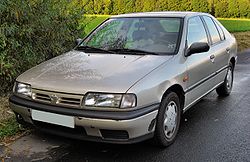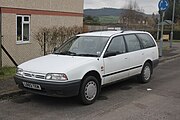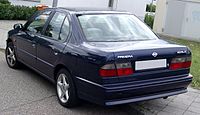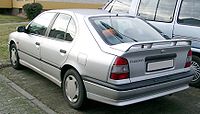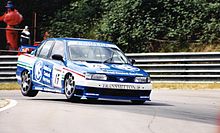Nissan Primera P10
| Nissan | |
|---|---|
|
Nissan Primera Hatchback (1990–1995)
|
|
| Primera P10 | |
| Production period: | 1990-1997 |
| Class : | Middle class |
| Body versions : | Sedan , hatchback , station wagon |
| Engines: |
Otto engines : 1.6–2.0 liters (66–110 kW) Diesel engine : 2.0 liters (55 kW) |
| Length: | 4400-4510 mm |
| Width: | 1695-1700 mm |
| Height: | 1390-1500 mm |
| Wheelbase : | 2550 mm |
| Empty weight : | 1110-1358 kg |
| Previous model | Nissan Bluebird |
| successor | Nissan Primera P11 |
The mid-range model Nissan Primera came onto the market in the fall of 1990 in the first P10 series as a direct successor to the Nissan Bluebird and was supposed to replace it in Europe. A sedan with a notchback or hatchback was available, as well as a station wagon , which Nissan calls Traveler . This model was also sold as the Infiniti G20 in the US .
Model history
The Primera was the first Nissan model to be specifically developed and produced for the European market. It appeared at the Paris Motor Show in October 1990 and was sold in Germany from the end of the month.
The technology of the Primera was newly developed, which made it possible to achieve very good handling. The front axle suspension of the Primera sedan is a hybrid construction consisting of a double wishbone wheel suspension and a spring strut . The slightly inclined upper wishbone, which is also known as the “third link”, is characteristic. This construction is the same from the P10 to the P11-144.
The sedan and station wagon variants are built on different platforms and have little in common apart from the name. In fact, the Traveler (W10 series) is based on the Japanese Nissan Avenir and therefore does not have the same chassis construction as the sedan.
As early as June 1993, the Primera received a small revision in which the safety equipment was expanded and the engines revised.
Facelift
In January 1995, all versions of the Primera received an extensive facelift . The safety equipment was further improved, driver airbags were now standard on board. Additional passenger airbags and belt tensioners were also available and part of the series in higher-quality equipment (SE, eGT).
The face-lifted sedan models were recognizable by a modified radiator grille with chrome inlays and modified, lower front and rear bumpers. The taillights were also given a more modern look in gray-red and the speedometer needles were henceforth red instead of the previously white ones. Two fog lights were now integrated into the front apron. The last Primera models of the P10 series met the Euro 2 emissions standard, but it was possible to retrofit the Euro 1 engines with a cold run controller (KLR) in some cases.
The estate version received a modified front apron, a different radiator grille and standard ABS. In June 1996 the Traveler was slightly revised again in order to produce it as a gap filler until autumn 1997. A replacement model was only released as WP11-120 after the facelift of the next Primera generation. This second facelift can be recognized by another modified radiator grille and also has passenger airbags and belt tensioners.
Equipment variants
- LX: basic version, manual windows , no electric mirrors
- SLX: Comfort version with 4 × eFH , electric and heated exterior mirrors, central locking, power steering , optional air conditioning available as a dealer upgrade.
- SRi (sports package in the look of the Primera GT): front spoiler, side skirts and rear wing (in body color), characteristic “SRi” lettering on the rear, on the sides and on the speedometer. Handbrake lever, gear knob and steering wheel edged in leather, sport seats with better lateral support. Delivered in the colors gemini blue, cherry red, tundra green or black. Mineral effect paint for an extra charge. Motorization in Germany: only 1.6 l with 90 hp.
- eGT: the sports version of the Nissan Primera: SR20DE 2-liter engine with 150 hp, 0–100 in 8.4 s and a top speed of 220 km / h. Visually emphasized sportiness through rear spoiler , side skirts, sports seats, alloy wheels and the like. v. m., such as an oil pressure gauge in the speedometer
- Invitation (name designation in Germany and Switzerland, among others): last special model of the Primera P10, delivered 1995–1996. Characteristic are the chrome inlays on the door handles and the radiator grille, the 14 "aluminum rims, manual air conditioning, double airbag, ABS as well as the roof antenna and quartz-colored taillights. You could also order the color" Ocean Green ", which was only offered for the Invitation. This was a light "candy green", which was later also available for the Nissan Micra. The invitation version was basically an upgraded version of the LX in terms of equipment: the front window lifters are electric, the exterior mirrors are also manual and cannot be heated, the trim strips are also not in At the time only available with 1.6 or 2.0 l engines (up to 116 hp in Germany, in other countries sometimes indicated as 125 hp).
- SE: the luxury version of the Nissan Primera, only available with a 2.0-liter engine. Outwardly recognizable by the light alloy rims with 195 tires, chrome-plated door handles and the “SE” logo on the rear. Leather seats with integrated seat heating were optionally available for the SE. Shift knob, steering wheel and handbrake lever covered in leather like the SRi and eGT, center console with root wood application, integrated cassette box included.
Motorization
When it was launched on the market in October 1990, there was a choice of three different petrol engines with an output between 66 kW and 110 kW and a diesel engine without a turbocharger with 55 kW. Depending on the version, the petrol engines were equipped with carburettors or manifold injection , but were all equipped with multipoint injection as part of a revision of the engine range in June 1993.
The two-liter 16V with 85 kW was also offered with all-wheel drive from April 1991, but only in the two sedans.
Nissan only offered engines that were designed as inline four-cylinder engines . The petrol engines have 16 valves , which are driven by a timing chain via two overhead camshafts . The petrol engines were described in a test report in a recognized car magazine as "the engine that can do everything". In fact, these engines were extremely robust and mileage of well over 300,000 km was not uncommon.
The diesel engine, however, only has eight valves that are operated via an overhead camshaft . The valve is controlled by a toothed belt .
| model | Displacement | Valves | Max. Power at min −1 |
Max. Torque at min −1 |
Identification code | construction time | variant | Others |
|---|---|---|---|---|---|---|---|---|
| Petrol engines | ||||||||
| 1.6 | 1597 cc | 16 | 66 kW (90 PS) / 6000 | 133 Nm / 4000 | GA16DS | 06 / 1990-05 / 1993 | Hatchback, notchback, station wagon | Carburetor |
| 1.6 | 1597 cc | 16 | 66 kW (90 PS) / 6000 | 136 Nm / 4000 | GA16DE | 06 / 1993-10 / 1997 | Hatchback, notchback, station wagon | Multipoint injection |
| 2.0 | 1998 cc | 16 | 85 kW (115 PS) / 6000 | 166 Nm / 4000 | SR20Di | 06 / 1990-05 / 1993 | Hatchback, notchback, station wagon | Central injection |
| 2.0 | 1998 cc | 16 | 92 kW (125 PS) / 5600 | 170 Nm / 4800 | SR20De | 06 / 1993-10 / 1997 | Hatchback, notchback, station wagon | Multipoint injection |
| 2.0 eGT | 1998 cc | 16 | 110 kW (150 PS) / 6400 | 181 Nm / 4800 | SR20DE | 06 / 1990-05 / 1993 | only notchback | Multipoint injection |
| 2.0 eGT | 1998 cc | 16 | 110 kW (150 PS) / 6100 | 181 Nm / 4800 | SR20DE | 06 / 1993-06 / 1996 | only notchback | Multipoint injection |
| diesel | ||||||||
| 2.0 d | 1974 cc | 8th | 55 kW (75 PS) / 4800 | 132 Nm / 2800 | CD20 | 06 / 1990-10 / 1997 | Hatchback, notchback, station wagon | Pre-chamber injection |
Motorsport
The Nissan Primera P10 was also used in touring car racing, especially in the German STW racing series and the British Touring Car Championship (BTCC), but also in the Japanese Touring Car Championship (JTCC).
In 1991, Nissan entered the BTCC with front-wheel drive Primera P10s built by Nissan Motorsports Europe in England. However, the success was limited, so that the manufacturer withdrew at the end of the 1994 season. After a year break, Nissan supported a private team and from 1997 started the next Primera generation with much more success in the BTCC.
In the STW Cup, Nissan was one of the manufacturers who participated in it from the start of the series in 1994. In the 1995 season, Nissan experimented with an all-wheel drive Primera, which, despite its well thought-out design and good weight distribution, could not keep up with the other two front-wheel drive vehicles used and had to be written off on its third use after an accident. The sad highlight of this year was the death of Primera driver Kieth O'dor , who, after winning the sprint race at the second run on the AVUS, went off the track for unknown reasons, hit a boundary wall and was rammed by a vehicle behind. Nissan then broke off participation in the current season, but returned in 1996 with a vehicle that was improved in terms of safety, which brought certain weight disadvantages with it. This season the Primeras mostly crossed the finish line with a placement in midfield. Revised P10s were still used in the 1997 season, but after a few runs these were replaced by the racing version of the successor model.
literature
- Joachim Kuch: Nissan since 1933. Motorbuch, Stuttgart 2005, ISBN 3-613-02491-8
Web links
Individual evidence
- ↑ Dave Coleman: Technobabble: Multilink and the Beam. In: Sport Compact Car - November '98. Retrieved November 29, 2015 .
- ^ Wouter Melissa: Nissan Primera GT BTCC. Ultimatecarpage.com, April 14, 2008, accessed November 29, 2015 .
